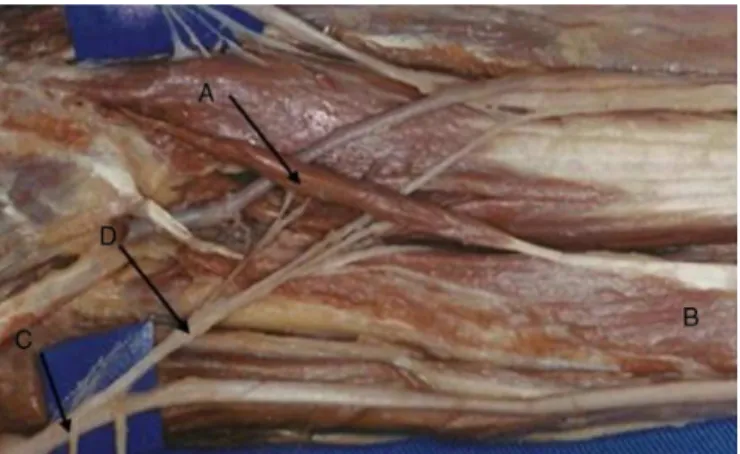rev bras ortop.2017;52(6):731–734
SOCIEDADE BRASILEIRA DE ORTOPEDIA E TRAUMATOLOGIA
w w w . r b o . o r g . b r
Case
Report
Accessory
muscle
of
the
flexor
digitorum
superficialis
and
its
clinical
implications
夽
Edie
Benedito
Caetano
a,∗,
João
José
Sabongi
Neto
b,
Lucas
Augusto
Ayres
Ribas
c,
Edson
Vinícius
Milanello
caDepartamentodeCirurgia,FaculdadedeCiênciasMédicasedaSaúdePontifícia,UniversidadeCatólicadeSãoPaulo,Sorocaba,SP,Brazil
bConjuntoHospitalardeSorocaba,Servic¸odeCirurgiadaMão,Sorocaba,SP,Brazil
cFaculdadedeCiênciasMédicasedaSaúde,PontifíciaUniversidadeCatólicadeSãoPaulo,Sorocaba,SP,Brazil
a
r
t
i
c
l
e
i
n
f
o
Articlehistory:
Received8August2016 Accepted13September2016 Availableonline21October2017
Keywords:
Muscleskeletal/abnormalities Nervecompressionsyndromes Cadaver
a
b
s
t
r
a
c
t
Anatomicalvariationsoftheflexordigitorumsuperficialis(FDS)muscleandtendonunitare frequentlyreportedbyanatomistsandclinicians.AnatomicalmusclevariationsoftheFDS anditstendonsmayincludevariationsofmusclebelly,presenceofaccessoryorduplicate tendons,abnormaltendonconnections, andabsence ofmuscleortendoncomponents. Suchvariations mayor maynot haveclinicalimplications.Thisreportpresentsa case notdescribedpreviously:aunilateralaccessorymuscleoftheflexordigitorumsuperficialis whichwasconnectedbyathicktendontotheflexordigitorumsuperficialismuscle;itwas directedproximallytotheinsertionofthemedialepicondyleofthehumerus,nexttothe superficialisheadofthepronatorteresmuscle.Thebellyoftheaccessorymusclewas pos-itionedanteriortothemedianandanteriorinterosseousnerve.Thisanatomicalvariation isknownastypeVintheclassificationofElliotetal.Theknowledgeoftheseanatomical variationshelpshandsurgeonsinterprettheclinicalexamination,particularlyinthe eval-uationofpatientswhohavesufferedtendoninjuriesorshowsignsofpossibleperipheral nerveentrapment.
©2017PublishedbyElsevierEditoraLtda.onbehalfofSociedadeBrasileiradeOrtopedia eTraumatologia.ThisisanopenaccessarticleundertheCCBY-NC-NDlicense(http:// creativecommons.org/licenses/by-nc-nd/4.0/).
Músculo
acessório
do
músculo
flexor
superficial
e
sua
implicac¸ão
clínica
Palavras-chave:
Músculoesquelético/anormalidades Síndromesdecompressãonervosa Cadáver
r
e
s
u
m
o
Variac¸õesanatômicas(anomalias)daunidademusculotendíneadoflexorsuperficialdos dedos(FSD)têmsidorelatadascomfrequêncianaliteraturaemtratados,artigosclínicose anatômicos.Podemocorrervariac¸õesdocorpomuscular,presenc¸adetendõesacessóriosou duplicados,conexõesmusculotendinosasanormaiseausênciadocomponentemuscularou tendinoso.Essasvariac¸õespodemounãoterimplicac¸õesclínicas.Osautoresapresentam
夽
PaperdevelopedattheFaculdadedeCiênciasMédicasedaSaúde,PontifíciaUniversidadeCatólicadeSãoPaulo,Sorocaba,SP,Brazil. ∗ Correspondingauthor.
E-mail:ediecaetano@uol.com.br(E.B.Caetano).
http://dx.doi.org/10.1016/j.rboe.2017.10.004
732
rev bras ortop.2017;52(6):731–734umcasonãodescritopreviamentedeummúsculoacessóriodomúsculoFSDunilateralque estavaconectadoatravésdeumtendãoespessoaomúsculoFSDedirigia-seproximalmente parainserir-senoepicôndilomedialdoúmeroaoladodacabec¸asuperficialdomúsculo pronadorredondo.Omúsculoflexorsuperficialacessórioposicionavaanteriormenteaos nervosmedianoeinterósseoanterior.Essavariac¸ãoseenquadranotipoVdaclassificac¸ão
deElliotetal.Oconhecimentodessasvariac¸õesanatômicasauxiliaocirurgiãodamãoa interpretaroexameclínico,emespecialnaavaliac¸ãodepacientesquesofreramlesões tendinosasouapresentamsinaisdepossíveiscompressãodealgumnervoperiférico.
©2017PublicadoporElsevierEditoraLtda.emnomedeSociedadeBrasileirade OrtopediaeTraumatologia.Este ´eumartigoOpenAccesssobumalicenc¸aCCBY-NC-ND (http://creativecommons.org/licenses/by-nc-nd/4.0/).
Introduction
Theflexordigitorumsuperficialis(FDS)muscleisthelargest muscleintheforearm.Itformsanintermediatemusclelayer betweenthesuperficialanddeepmusclegroups.Themedian nerve and the ulnar artery enter the forearm as it passes between its radialand humeral-ulnar heads. However,the relationshipofthemediannervetothetwoheadsoftheflexor digitorumsuperficialismayshowanatomicalvariations.
Theupperlimbmay haveduplicateandaccessory mus-cles,as well asanomalous muscles. Anatomical variations of the flexor digitorum superficialis and its tendons are not uncommon: variations of the muscle belly, abnormal musculotendinous connections, absence of the tendinous component, particularly of the little finger, have been described inclinical and anatomicalstudies.1,2 These
vari-ations may or may not have clinical implications. The knowledgeof these anatomical variationshelps hand sur-geonstointerprettheclinicalexamination,especiallyinthe evaluation of patients who experienced tendon lesions or showsignsofpossiblecompressionofanyperipheralnerve.
Elliotetal.3 discussthedevelopmentofflexordigitorum
superficialisfromamphibianstohumans;theyreviewedmore than30articles,andclassifiedthevariationsintofivetypes. TypeI:connectionbetweenthetendonsofthemuscleitself. TypeII:connectionbetweentheFDSmuscletendonsandthe flexorretinaculum.TypeIII:digastricsuperficialflexormuscle. TypeIV:distalextensionofthemusclebellyoftheFDS.Type V:anatomicalvariationsoftheFDSmuscleintheforearm.
Case
report
Wepresentacasethathasnotbeenpreviouslyreportedofa unilateralsuperficialflexoraccessorymuscleidentifiedduring routineanatomicaldissectionsmadebyresidentsandmedical studentsoftheOrthopedicsandTraumatologyDepartment. The study is registered in the Research Ethics Committee underno.1.025.516.Thepurposeofaseriesof100dissections wastorecordanatomicalvariationsintheupperlimb focus-ing on the presenceof anomalous nerve communications (e.g.,MartinGruber’sanastomosis),anatomicalvariationsof muscles and its tendons(e.g., Gantzer muscle), aswell as theperipheralnerves,andtoanalyzethepossibilityofthese variations being responsible for pathologies, especially for
compressive syndromes. The dissection of each limb was madethroughamedianincisionthroughouttheforearm, mid-dleandlowerthirdofthearm;twoflaps,includingtheskin andthesubcutaneoustissue,werereflectedtotheradialand ulnar sides, respectively; thesame wasdone inrelationto the forearmfascia, withtheentiremusculaturethus being exposed.Inoneoftheselimbsweidentifiedthisrare vari-ationdescribed.Itwasfroma57-year-oldmalecadaver.We donothaveanysignificantindividualclinicalhistory.There was noevidenceofany surgicalprocedure inthearm and forearm.Thelongpalmarismusclewaslackingbilaterally.All otherforearmmuscleswerepresentandshowednovariation. Thecontralateralforearmwasanatomicallynormal,except fortheabsenceofthelongpalmarismuscle.Theanomalous musclewasconnectedtotheflexordigitorumsuperficialis.It consistedoftwomusclebelliesseparatedbyanintermediate tendon,directedproximallytoinsertitselfontothemedial humerusepicondylenexttothesuperficialheadofthe prona-torteresmuscle.Theaccessorysuperficialflexormusclewas positionedanteriortothemedialandanterior interosseous nerves. The anomalous muscle was dissected away from theotherstructuresandstudiedindetail.Themuscle mea-surements were made and the forearm was photographed (Figs.1and2).Themaximumthicknessoftheaccessory mus-cle was2.5cmand the length9cm. Themuscle (FDS) and its accessorymusclereceivedinnervationfrom themedian nerve.
rev bras ortop.2017;52(6):731–734
733
Fig.2–(A)Accessoryflexordigitorumsuperficialis (anatomicalvariation),mediallyreflected.(B)Intermediate tendon.(C)Superficialheadofthepronatorteres(medially reflected).(D)Flexordigitorumsuperficialis.(E)Median nerve.
Discussion
Anatomical variations of the flexor digitorum superficialis muscles are not uncommon; they may mimic soft tissue tumorsor causenerve compression.Theanatomical varia-tionsthathavebeendescribedmostfrequentlyoccurinthe palm ofthe hand.4,5 In amphibians, the superficial flexors
arisefromthepalmofthehandandduringthecourseof evo-lutionthesemusclesmovetotheforearm.6Itispossiblethat
thepresenceofthemusclebellyinthehandrepresentsthe persistenceofanintermediatestageofevolution.7,8
Themusclecomponentoftheflexordigitorumsuperficialis mayoccasionallyextendintothecarpaltunnelandmaybe identifiedduring surgeryfordecompression ofthe median nerveinthecarpaltunnel.Duringthefingerflexion-extension movementthe tendonsmovewithinthe carpaltunneland mayfrequentlycauseintermittentsymptomsduringdigital flexion.9,10
Elliotetal.3reportedacaseofanatomicalvariationtypeV,
statingthatthiswasararevariation.Duringthesurgical pro-cedure,theyidentifiedasmallmuscleattachedbyatendonto theflexordigitorumsuperficialismuscleofthemiddlefinger, 8cmproximaltothewristfold;thissmallmusclecrossedthe mediannerveanteriorly,andwasattachedtothedeepsurface ofthetransversecarpusligament;itwassuperficialtothe nor-malsuperficialflexortendonsandtothemediannerve;this variationisconsideredunlikelyasbeingthecauseofmedian nervecompression.Theydescribedanothersurgicalcase(type I)inwhichtherewasasmallanomalousmuscleattachedto thetendonoftheflexordigitorumsuperficialisproximallyand distallytotheindexfingerinthepalmofthehand;during digitalflexion,thisanomalousmusclepenetratedthecarpal tunnelthusincreasingthecontentofthetunnel,whichcan causeintermittentsymptoms.Theydescribedathirdcaseof typeIVinwhichtheflexormusclebellyoftheindexfinger extendedtotheinteriorofthecarpaltunnelandincreasedits content.
TheliteraturereportsothercaseswithtypeVanatomical variation.ThefirstwasreportedbyMainland.1Incadaveric
dissection,he observeda variationof the flexordigitorum
superficialis,inwhichthetendonsoftheringandsmallfingers wereconnectedtothreemuscles;twowereintheforearm,the longpalmarismusclewasabsent.ThesecondcaseoftypeV wasreported byFigueiredo andHooper11;inthiscasethey
found,duringasurgicalprocedure,ananomalousmusclein theforearm,whichcausedtheflexionoftheproximal inter-phalangealjointoftheindexfingerwhenpulled;themedian nerve wassituatedsuperficiallytothis muscleinthe fore-armandwrist;theystatedthatthelimitedsurgicalincision didnotallowbetterexploration.Themostemblematiccase oftype(V)wasdescribedbyFromont.12Duringdissectionof
thehandofacadaver,thepresenceoffouranomalousflexor digitorumsuperficialismuscleswasidentified,whicharosein theretinaculumoftheflexorsandwereinsertedinthebaseof themiddlephalanxofthefourfingersandactedasflexorsof theproximalinterphalangealjoint;thenormalflexor digito-rumsuperficialismusclelocatedintheforearmhadonlytwo tendons,oneforthemiddlefingerandtheotherforthering finger.Inthecontralaterallimb,theflexordigitorum superfi-cialismusclehadonlytwotendonsforthemiddleandring fingers,whichwereinsertedintotheflexorretinaculum. Yesi-ladaetal.13reportedthatduringthesurgicalprocedurethey
observedacaseoftypeVanomaly;therewasasingle,well developedmuscleextendingtothepalmofthehandwithout the presenceoftendons;tractioninthe musclecausedthe flexionoftheproximalinterphalangealjointoftheindex, mid-dle,ringandsmallfingers;thepalmarlongmusclewasabsent. Stilland Kleinert8identified, duringsurgicalprocedures,
twocases(typeIV)inwhichthemusclecomponentextended distally to the carpal tunnel and were described as “aber-rantmuscles”;theyreportedthatduringtheflexion-extension movementsofthefingersthesemusclesenterand exitthe carpaltunnelandmaycausesymptomsofmediannerve com-pression.
EliasandSchulter-Ellis14reportedthesurgicalcaseofan18
yearoldmalepatientinwhichtheyrecordedtheexistenceof digastricmuscle(typeIII)thatwasinsertedatthebaseofthe middlephalanxoftheindexfinger,hadaproximalpathand passedunderthecarpaltunnel;however,asitwasasurgical case,itcouldnotbeexploredproximally.Theyreporteda sec-ondsurgicalcaseinwhichthemuscleinsertedintothesiteof theflexordigitorumsuperficialisoftheindexfinger,andthe musclecomponentpassedthroughthecarpaltunneltoward theforearm.
StillandKleinert8reportedsimilarcasesofTypeIIanomaly
inwhichtheanomalousmusclearoseintheflexor retinacu-lumandwasattachedtothetendonoftheflexordigitorum superficialisinthedistalpartofthepalm.Hammer-Villar14
reportedasimilarcase(TypeII)inwhichtheanomalous mus-clearoseinthethenarregion,andwasattachedatthebase of the middle phalanx of the index finger. Wesser et al.7
describedthepresenceofanatavisticFDSmuscleoriginating in the palmar aponeurosisand the transverse carpal liga-ment,andinsertedintothebaseofthemiddlephalanxofthe indexandmiddlefingers.Alltheseauthorsagreethatthese anatomicalvariationsareatavistic,occurasaconsequence oftheinterruptionofsomestageofdevelopmentasinthe amphibians.
734
rev bras ortop.2017;52(6):731–734Fig.3–ByanalogywithGantzer(A)muscle,alsocalled accessorytotheflexorpollicislongus(B),whichisfrequent becauseitoccursin68%ofthelimbs,wecallthisrare muscleasaccessoryoftheflexordigitorumsuperficialis. (C)Mediannerve.(D)Anteriorinterosseousnerve.
consideredthatmostofthedescribedanatomicalvariations were identifiedinthe palmofthe hand,and onthe distal thirdof the forearm duringsurgical procedures of decom-pressionofthecarpaltunnel,andinthesecasestheincision waslimited.Wehaddoubtsaboutthedenominationofthis anatomicalvariationwereported.Wecouldcallit“digastric flexordigitorumsuperficialismuscle”,becausetheanatomical nominaconsiders thattwo musclebellies joinedbya ten-donshouldbecalled thisway. TheGantzermuscle (Fig.3) presentin68%oftheforearmsisalsocalledaccessorymuscle oftheflexorpollicislongusmusclebecauseitisasmall mus-clethatjoinstheflexorpollicislongusmuscletothemedial epicondyleofthehumerusortothecoronoidprocessofthe ulnaand adjacencies;thus,duetothesimilarity and anal-ogy,itwastermed“accessorymuscleoftheflexordigitorum superficialis”.Itcouldevenbeconsideredasavariationofthe humeralinsertionofthe“proximallyexpandedflexor super-ficialismuscle”withthepresenceofanintermediatetendon. Inanycase,wedidnotrecordtheanatomicalvariationthat wehavedescribedinthemainclassicalmanualsofanatomy andinourresearch.Wedonothavetheclinicalhistoryofthis cadaver,butweidentifiedthattheaccessoryflexormuscleof theFDSwasanteriorlysituatedtotheanteriormedianand interosseousnerves,andcouldpotentiallybethecauseofthe compressivesyndromeoftheanteriorinterosseousnerveor ofthepronatorteressyndrome.
Theexcisionoftheseanomalousmusclesiscontroversial andeachcaseshouldbeanalyzedindividually.Wesseretal.7
considerthatsurgeryisnotnecessary,becausethese anatomi-calvariationsmaybepartofthefunctionalunitthatmakesthe
digitalflexion,andmaycausesomefunctionalimpairment. Vichare4alsodoesnotresecttheseanomalousmusclesifthere
are no painful symptoms or nerve compression. Elias and Schulter-Ellis14recordedthepresenceofthesevariationsin
ninecasesandallwereoperatedon.Kostakogluetal.2prefer
surgerybecause theyconsider thattheseabnormalities are potentiallypainfulorcausecompressionsyndromes.
Conflicts
of
interest
Theauthorsdeclarenoconflictsofinterest.
r
e
f
e
r
e
n
c
e
s
1.MainlandD.Anuncommonabnormalityoftheflexor digitorumsublimismuscle.JAnat.1927;62Pt1:86–9.
2.Kostako ˘gluN,BormanH,Kec¸ikA.Anomalousflexor
digitorumsuperficialismusclebelly:anunusualcaseofmass inthepalm.BrJPlastSurg.1997;50(8):654–6.
3.ElliotD,KhandwalaAR,KulkarniM.Anomaliesoftheflexor digitorumsuperficialismuscle.JHandSurgBr.
1999;24(5):570–4.
4.VichareNA.Anomalousmusclebellyoftheflexordigitorum superficialis.Reportofacase.JBoneJointSurgBr.
1970;52(4):757–9.
5.SpinnerM.Injuriestothemajorbranchesofperipheral nervesoftheforearm.2nded.Philadelphia:W.B.Saunders; 1978.
6.WesserDR,CalostypisF,HoffmanS.Theevolutionary significanceofanaberrantflexorsuperficialismuscleinthe humanpalm.JBoneJointSurgAm.1969;51(2):396–8.
7.StillJMJr,KleinertHE.Anomalousmusclesandnerve entrapmentinthewristandhand.PlastReconstrSurg. 1973;52(4):394–400.
8.TanzerRC.Thecarpal-tunnelsyndrome;aclinicaland anatomicalstudy.JBoneJointSurgAm.1959;41(4):626–34.
9.BaruchA,HassA.Anomalyofthemediannerve.JHandSurg Am.1977;2(4):331–2.
10.FigueiredoUM,HooperG.Abnormalcourseofthemedian nerveassociatedwithananomalousbellyofflexordigitorum superficialis.Hand.1980;12(3):273–4.
11.FromontNI.Anomaliesmusculairesmultiplesdelamain, absencedufle´chisseurpropreduponce;absencedesmuscles del’e ´minencethenar;lombricauxsupple ´mentaires.BullSoc AnatParis.1895;70:395–401.
12.YesiladaAK,TatlıdedeHS,C¸akmakE,KıyakMV,Kılınc¸L. Anomalouslargeuniquemusclebellyofflexordigitorum superficialisandtheabsenceofPalmarislongusinthe forearm.JPlastReconstrAesthetSurg.2013;66(1):137–9.
13.EliasLS,Schulter-EllisFP.Anomalousflexorsuperficialis indicis:twocasereportsandliteraturereview.JHandSurg Am.1985;10(2):296–9.


